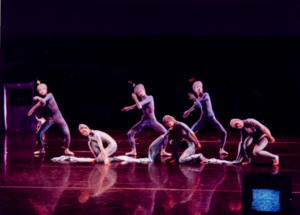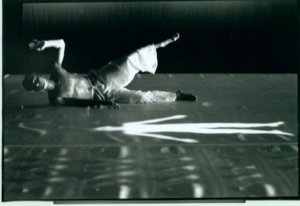Multimedia Performance – Art or not?
Tangling Tango Tale
2005-11-21國際藝評研討會2006
2006-10-27Performance Program: Multimedia Performance – Art or not?
Author: Koala Yip
Prelude
The emergence of New Media Theatre is a process of mutual absorption between the art of theatre and digital technology. In the theatre performance field, it is a new brand that almost everyone what to share a taste. Indeed, certain misconceptions fabricate a misty phenomenon to barricade the innermost subject. One would complain digital media generates too much problems to in theatre: it’s unstable, unpredictable and hard to trust; it’s either too captivating or ineffective in performance. The fact is, more and more artist involve in multimedia performance proved that there is a need to treat digital media as an artistic expression.
It’s pretty much pointless to argue along on the technical side. Digital technology is developing in multiplying speed. Today’s technical crisis is more likely solved in the very near future. We properly would encounter serious depression if we try to ground an aesthetic definition or theoretical principle based on recent usage of media types. First, I don’t think all digital media types comprise performance potentials had been utilized yet. Second, artistic application of digital media is still a blurred area and it requires further investigation of both artist and technologists.
One possibility in discussing artistic aspect of new media theatre is to revisit the central belief of theatre performance. How concepts from digital media can assimilate into theatre performance? In what way we see internal transformation of traditional theatre concepts such as performer, stage, audience, storytelling, etc.? Will the nature of theatre a different scene in multimedia context?

Conceptual Framework For Multimedia And Theatre Experience
According to Wikipedia encyclopedia, “Multimedia is the use of several different media to convey information (text, audio, graphics, animation, video, and interactivity). …. As the information is presented in various formats, multimedia enhances user / audience experience and makes it easier and faster to grasp information. …. multimedia generally implies presenting information in various digital formats.” In this definition, the birth of multimedia is to enhance the communication process with digital technology.
Information is a vital part of human experience. Human experience is based on information reception through five basic senses: see (visual), hear (audio), feel (touching), smell (olfaction) and taste (guestation). If multimedia’s prime task is to enhance user / audience experience, the perfect picture is audience can receive intensified signals through all the five physical sensory channels.
Recent definition on multimedia focuses on digital media. This gives a problem when we look at digital media in theatre. Up to recent development, digital media gained enormous success in visual and audio assimilation. But little had been done for the rest of the three types of human senses. In other words, recent digital media can only serve as agent for partial human experience, not the whole.
In contrast, theatre delivers a richer experience. In theatre performance, not only visual and audio stimulations make the magic. The stage settings, pressure in the air, temperature of space, and even tiny sound or movement from audience also contribute to a multi-dimensional theatre atmosphere. Basically, physical reality is already in 3-dimensional domain. If sending information is the only purpose in theatre performance, the demand on digital media is relatively low. Let’s look at a simple case: if we want to present “affection”, are there any way better than witnessing two people actually embracing or kissing in live situation? Will the audience “experience” more sense of affection when they are watching two people kissing in a video clip projected somewhere on stage?
Application of digital media in theatre performance cannot and should not replace existing theatre element, but as an agent to transform those elements. The concept of media transformation should be the main subject matter, not the media itself.
key concepts for the interpretation of evolving multimedia forms: including integration, interactivity, hypermedia, immersion, and narrativity.
Nature of Digital media and it’s applicability on theatre performance
- spatial transformation
- augmented reality
- interactivity – reactivity
The emergence of New Media Theatre is a process of mutual absorption between the art of theatre and digital technology. In the theatre performance field, it is a new brand that almost everyone what to share a taste. Indeed, certain misconceptions fabricate a misty phenomenon to barricade the innermost subject. One would complain digital media generates too much problems to in theatre: it’s unstable, unpredictable and hard to trust; it’s either too captivating or ineffective in performance. The fact is, more and more artist involve in multimedia performance proved that there is a need to treat digital media as an artistic expression.
Multimedia Myth
I would like to discuss a few scenarios found among so-called “multimedia performances” which I would describe as common multimedia myths in theatre.
The first scenario is abuse of use in digital video technology. This issue connects to the nature of modern digital media. As mentioned above, recent digital media can only serve partial human experience. It’s most compelling achievement is in visual sense. “Larger than life” video images became the only holy g
One of them relates to real intention of media usage. I believe we have seen over a dozen “multimedia performances” like this: high-resolution video projector stretching oversized video images that hovers the entire stage. Meanwhile, tiny-looking performers struggle to stay in well-lited areas. Multimedia performance is still a “selling point” for funding bodies, audience and even the artist themselves. If a performance already labeled as “multimedia” in the beginning of the creating process, it’s easy to fall in a trap: “multimedia for the sake of multimedia”. People make digital media too captivating. They try too hard to show the audience their new toys. As a result, digital media is exhibited in a focal point, like saying loudly, “Hey! Everybody, look! We got projectors! We got computers!” On the other hand, digital media was blamed of it’s unfriendliness to corporate with other performance element.
What is informational art?
1. Visual projection: The relationship between stage lighting and video projection should merge as an integral driving force. A common issue existing in theatre performance is contradiction of projection light and stage light. In lots of cases, video projection usually has one clear destination: light source from projection would travel through certain distance and land on a surface aims to reflect desired images. Color tone, focus, luminance level, perspective, dimension are variables of the projection. The space between projection light source and the reflective surface should not be interfered. Any tangible element, like a performer would cast showdown on the surface as soon as the “scared space” was interfered. This cause problem if the shadow effect is not in the plot. A rare / back projection would solve the shadow problem but a vast amount of space from backstage are required to accommodate this solution. In contrast, projection scenario is only minor part of stage lighting. Stage lighting intends to “paint” the air with color and texture, to produce specific mood or transformation of time and space. Its targets usually fall on performing components such as performers and stage set. Excellent lighting design is able to create emotion along with the performance on stage. If we are talking about installation, problem can be solved by well-planned in placement of all elements. But this is not the case of theatre performance. Performers, a performance’s main parameter, are not still objects but living being which would migrate from place to place within the performing environment.(note: virtual and live presence of human ) . This means relationship with performers and light source is a constant changing journey. As a result, stage lighting would end up desaturate the projection image. Or performers may not be given enough attention when stage light tries to comprise.
2. With more artists familiar with digital media, creator of theatre performance is able to create spatial representations beyond traditional backdrop. Only by breakaway from 2D to the 3D world that integration of live performance and stage environment would be valid. There is three ways to see this potential:
- To create a virtual / augmented environment through various projection screen. The environment would be able to respond to the live performer or / and to alter according to the narrative. (note: recent technology advancement on LCD screen may be an alterative of video projection. LCD screen has less conflict against surrounding lights and does consume any space between source and display surface. In 2002, electronic company, Philips’ developed a revolutionary ‘Paintable LCD’ technology opens up the possibility of creating LCDs that conform to curved and irregularly shaped surfaces)
- An effective system for artist to create an immersive environment as virtual / augmented reality. This would extend the performing space into a surround setting. Such architecture would possibly remove physical boundary between stage section and audience region.
- Video should not be used as merely a way to exhibit image on particular 2D surface, but also an effective source which can illustrate the whole space. (note: similar to the concept of hologram)
Conclusion:
Raw data or information is not art. Art has to go through a process of transformation, assigned a kind of denotation, this may be actively by the artist or determined by spectators. Not matter how this process works out, there is activity of human expression and reception. Art redefines how reality displays and gives specific meaning to life.
In my opinion, theatre performance still strives to carry a mission, no matter from philosophical or realistic point of view. The art of performance is an act to verify survival of humanity. Appearance of new media theatre would challenge theatre practitioners to eventually develop a more open idea on digital imaging on theatre space. Video projection is just a beginning.









